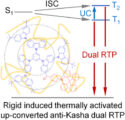Stefan Grimme, University of Bonn, Germany, develops methods for theoretical chemistry. Here, he talks to Catharina Goedecke for ChemViews Magazine about his research, in particular, about the popular DFT-D3 method used to account for dispersion interactions in density functional theory (DFT) calculations.
Grimme won the prestigious Gottfried Wilhelm Leibniz Prize, the highest honor awarded in German research, in 2015. He received the Schrödinger Medal from the World Association of Theoretical and Computational Chemists (WATOC), which honors outstanding theoretical and computational chemists, in 2013. He is included in the Highly Cited Researchers 2018 provided by Clarivate Analytics, which lists researchers ranked in the top 1% by citations for their field and year.
What is your research focused on?
I am a theoretical chemist. Our research focuses on large molecules, which in this context means 1,000 or maybe 2,000 atoms. We are moving the borders, hopefully, to as many as 10,000 atoms—and we want to do quantum chemistry, a quantum-mechanical description of matter. We are basically moving in the direction of accurately describing the condensed phase.
What are your most important contributions to theoretical chemistry?
As you might know, density functional theory, or DFT, is the most widely used electronic-structure method nowadays. I would say 90 % of all electronic structure calculations are conducted using DFT. My most important contributions are in this field. I have developed density functionals, more precisely, I introduced a new type of density functional, which is called double-hybrid density functional [1].
Secondly, maybe even more important contributions—because they are widely used in the community—are dispersion corrections to DFT [2], which are important to “repair” a very basic failure of this quantum mechanical method.
In general, I am interested in methods that are applicable to big molecules, and there are not many wave-function-based methods that can be used routinely for, say, a few hundred atoms. One is Møller–Plesset perturbation theory, with the so-called MP2 variant as a standard model which was widely used in the 1980s and 90s. This method, by the way, includes dispersion effects that we have to correct for in DFT. MP2 is a well-defined, good theory, but not accurate enough for many purposes. I had a simple idea to make it more accurate with the same computational effort. This is called the spin-component scaling or SCS concept [3], which is now used in various areas of wavefunction theory, not only for MP2.
Why is DFT so popular?
It is popular because it has a good ratio between performance and computational cost. It is very fast, much faster than many wavefunction methods that have the same accuracy. This is still one of the major advantages of the method. DFT is also robust, meaning even in very difficult cases, it usually gives a not-too-bad answer—often much better than wavefunction theory.
You talked about the need to correct for dispersion interactions in DFT. What are dispersion interactions, exactly?
First of all, the important thing to understand is that dispersion—the electrostatic interaction caused by fluctuations in the electron distribution—is always present in any system that has more than one electron. The importance increases with the system size, so if one is interested in large systems—for example, proteins or the condensed phase—with a dense packing of atoms or electrons, then including dispersion interactions is crucial.
Dispersion is always attractive, which is also important to know. It counterbalances other, always repulsive forces. When it is in good balance with these repulsive forces, you get the right answer for the right reasons. Methods that do not account for dispersion are overrepulsive and everything will be not bound tightly enough. This is why it is important to have a consistent description of both the repulsive and the attractive interactions in quantum-chemical methods, and dispersion is always a part of that.
How big is the error that is caused by ignoring dispersion?
That depends very much on the size of the system. Actually, the effects of dispersion have been mostly overlooked for decades, because in the early days of quantum chemistry, people were interested in relatively small systems, where it can be easily overlooked. But if you have a molecule of, say, 50 atoms, there are effects sizing up to kcal per mole, which are thermodynamically relevant. They are relevant for reaction barriers, reaction energies, molecule structures, et cetera.
Are there any simple examples of systems where ignoring dispersion interactions gives the wrong result?
One interesting example is the story of simple alkanes. The textbook way to introduce alkanes is showing the linear, zig-zag forms. But alkanes have branched isomers and these isomers are often more stable than the linear forms. The thermodynamic reason for this is that their dispersion energies are bigger because they are more compact and the electrons are closer together. If you neglect the dispersion, you get the wrong result for the more stable isomer. Such isomerizations are very simple reactions, and yet, you can already see big failures when you ignore dispersion.
So, dispersion is not only important for intermolecular interactions, but also within molecules?
Yes, it is a new understanding of the past five or ten years that intramolecular dispersion effects in bigger systems are also very important. 30 years ago, nobody would have considered these dispersion effects.
Why are dispersion interactions not included in standard, “uncorrected” DFT methods?
The standard density functionals consider electron density as a static object, which does not react to another density properly. It reacts only partially—the fluctuation of electron densities is not treated correctly at intermediate or large distances, only when they are very close. For a correct description, the electron densities have to polarize each other dynamically, which is difficult to include in standard DFT.
You fixed this problem using methods such as DFT-D3. How do they work?
In fact, this was not my idea. Maybe you could say I am the person who popularized it. Similar correction schemes were already invented in the 1970s in the context of the wavefunction-based Hartree-Fock theory, which also lacks dispersion effects. But then it was almost forgotten, because dispersion was not a big effect in the small systems that were investigated in the 70s and nobody was interested in the topic.
At the beginning of the 2000s, my colleagues and I basically reinvented this method. It is, in a way, a semiclassical approach, where you “condense” the effect to atoms, which is computationally much faster, simpler, and more robust than considering the full electron density. The description is based on quantum mechanics, but dividing the effects for the separate atoms makes the method much more efficient.
Which interactions between atoms are considered in these methods?
In the standard DFT-D3 method, for example, we consider two- and three-body interactions. The two-atom or “pairwise” term is by far the largest, giving roughly 90 % of the dispersion energy. You basically only have to compute and add up all pairwise interactions in your system, based on the distance and the strength of the interaction.
The distance between atoms is easy to determine; the strength of the interaction is the tricky part. You have to assign a property to an atom in a molecule. In quantum mechanics, there are no actual atoms in a molecule, only nuclei surrounded by an electron density.
Dispersion interactions are proportional to polarizability, and polarizability is proportional to volume. So you have to partition the molecule’s volume into atomic volumes. Then you assign a value for each atom’s contribution to the polarizability and the dispersion. These values depend on the type of atom and how many electrons it has, on its hybridization, and on the oxidation state. This polarizability data is precomputed using small model systems and very exact methods.
You pointed out that these corrections are very efficient. How much computer time does it take to include them?
Because the “costly” polarizability data is precomputed, the actual calculation time of the dispersion correction for your molecule is negligible. It is orders of magnitude faster than the overall DFT calculation. So in a DFT context, the dispersion correction costs basically nothing. This is different, however, when these corrections are used for force-field or semiempirical methods, which are inherently much faster than DFT.
Is there more work to be done on dispersion corrections?
I would say that the dispersion problem is by and large solved for most chemical systems on the level of accuracy we are interested in when using DFT. Now, many chemical applications and functions can be explored with this technology and the novel insight on dispersion.
We have recently published the DFT-D4 method [4,5], which properly includes the dependence on charge and oxidation state. By this, the method has reached a kind of plateau regarding the ratio between accuracy and computational cost. As with previous corrections, the DFT-D4 code is available free of charge from our homepage. Now, we can move on to other important problems—and in my opinion, solvation is the next problem to tackle.
Are you working on that?
Yes. We are working on explicit solvation models using extremely fast tight-binding quantum chemistry methods, which also must include dispersion corrections [6].
So you are moving on?
You have to move on, this is science, right?
Thank you very much for the interview!

Stefan Grimme was born in Braunschweig, Germany, in 1963. He studied chemistry at the University of Braunschweig, where he received his Ph.D. in 1991. He completed his habilitation at the University of Bonn in 1997 and became Lecturer there in 1999. In 2000, Grimme joined the University of Münster, Germany, as Professor for Theoretical Organic Chemistry. He returned to Bonn as Professor for Theoretical Chemistry in 2011.
References
- [1] Double-hybrid density functionals,
Lars Goerigk, Stefan Grimme,
Wiley Interdiscip. Rev.: Comput. Mol. Sci. 2014, 4, 576–600.
https://doi.org/10.1002/wcms.1193 - [2] A consistent and accurate ab initio parametrization of density functional dispersion correction (DFT-D) for the 94 elements H-Pu,
Stefan Grimme, Jens Antony, Stephan Ehrlich, Helge Krieg,
J. Chem. Phys. 2010, 132, 154104.
https://doi.org/10.1063/1.3382344 - [3] Spin-component-scaled electron correlation methods,
Stefan Grimme, Lars Goerigk, Reinhold F. Fink,
Wiley Interdiscip. Rev.: Comput. Mol. Sci. 2012, 2, 886–906.
https://doi.org/10.1002/wcms.1110 - [4] Extension of the D3 dispersion coefficient model,
Eike Caldeweyher, Christoph Bannwarth, Stefan Grimme,
J. Chem. Phys. 2017, 147, 034112.
https://doi.org/10.1063/1.4993215 - [5] A Generally Applicable Atomic-Charge Dependent London Dispersion Correction Scheme,
Eike Caldeweyher, Sebastian Ehlert, Andreas Hansen, Hagen Neugebauer, Sebastian Spicher, Christoph Bannwarth, Stefan Grimme,
ChemRxiv 2019.
https://doi.org/10.26434/chemrxiv.7430216.v2 - [6] GFN2-xTB—An Accurate and Broadly Parametrized Self-Consistent Tight-Binding Quantum Chemical Method with Multipole Electrostatics and Density-Dependent Dispersion Contributions,
Christoph Bannwarth, Sebastian Ehlert, Stefan Grimme,
J. Chem. Theory Comput. 2019.
https://doi.org/10.1021/acs.jctc.8b01176
Selected Publications
- B97-3c: A revised low-cost variant of the B97-D density functional method,
Jan Gerit Brandenburg, Christoph Bannwarth, Andreas Hansen, Stefan Grimme,
J. Chem. Phys. 2018, 148, 064104.
https://doi.org/10.1063/1.5012601 - Biomolecular Structure Information from High-Speed Quantum Mechanical Electronic Spectra Calculation,
Jakob Seibert, Christoph Bannwarth, Stefan Grimme,
J. Am. Chem. Soc. 2017, 139, 11682–11685.
https://doi.org/10.1021/jacs.7b05833 - Fully Automated Quantum-Chemistry-Based Computation of Spin-Spin-Coupled Nuclear Magnetic Resonance Spectra,
Stefan Grimme, Christoph Bannwarth, Sebastian Dohm, Andreas Hansen, Jana Pisarek, Philipp Pracht, Jakob Seibert, Frank Neese,
Angew. Chem. Int. Ed. 2017, 56, 14763–14769.
https://doi.org/10.1002/anie.201708266 - A look at the density functional theory zoo with the advanced GMTKN55 database for general main group thermochemistry, kinetics and noncovalent interactions,
Lars Goerigk, Andreas Hansen, Christoph Bauer, Stephan Ehrlich, Asim Najibi, Stefan Grimme,
Phys. Chem. Chem. Phys. 2017, 19, 32184–32215.
https://doi.org/10.1039/c7cp04913g - How to Compute Electron Ionization Mass Spectra from First Principles,
Christoph Alexander Bauer, Stefan Grimme,
J. Phys. Chem. A 2016, 120, 3755–3766.
https://doi.org/10.1021/acs.jpca.6b02907 - Dispersion-Corrected Mean-Field Electronic Structure Methods,
Stefan Grimme, Andreas Hansen, Jan Gerit Brandenburg, Christoph Bannwarth,
Chem. Rev. 2016, 116, 5105–5154.
https://doi.org/10.1021/acs.chemrev.5b00533
Also of Interest
- Cobalt-Catalyzed C–H Activation of Indoles,
Elliot Steeples,
ChemViews Mag. 2017.
Functionalization of aromatic systems under mild conditions - Shortest H···H Contact between Hydrocarbon Molecules,
ChemistryViews.org 2017.
London dispersion forces enable unusual bonding - Leibniz Prize 2015,
ChemViews Mag. 2015.
Germany’s most prestigious research prize awarded - Author Profile: Stefan Grimme,
Angew. Chem. Int. Ed. 2013, 52, 9076–9077.
https://doi.org/10.1002/anie.201301621




